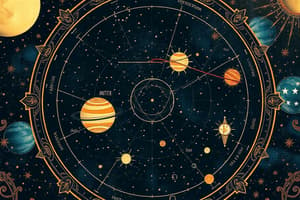Podcast
Questions and Answers
What is the primary process that powers the Sun?
What is the primary process that powers the Sun?
- Nuclear fission of helium
- Chemical combustion of hydrogen
- Gravitational contraction of gases
- Fusion of hydrogen into helium (correct)
Which of the following is NOT classified as a terrestrial planet?
Which of the following is NOT classified as a terrestrial planet?
- Venus
- Mars
- Jupiter (correct)
- Earth
Over what percentage of the Solar System's mass does the Sun account for?
Over what percentage of the Solar System's mass does the Sun account for?
- 75.86%
- 50.00%
- 59.84%
- 99.86% (correct)
Which planets are classified as gas giants within the Solar System?
Which planets are classified as gas giants within the Solar System?
What is the heliopause?
What is the heliopause?
Which of the following is classified as a dwarf planet?
Which of the following is classified as a dwarf planet?
Which of these bodies is NOT considered a small Solar System body?
Which of these bodies is NOT considered a small Solar System body?
What is the Oort cloud theorized to be the source of?
What is the Oort cloud theorized to be the source of?
What is the e-Courts project a Mission Mode Project of?
What is the e-Courts project a Mission Mode Project of?
When was the Phase-I of the e-Courts project approved?
When was the Phase-I of the e-Courts project approved?
How many District and Subordinate Courts were enabled by the e-Courts project during Phase-I?
How many District and Subordinate Courts were enabled by the e-Courts project during Phase-I?
What was the focus of Phase-II of the e-Courts project?
What was the focus of Phase-II of the e-Courts project?
The e-Courts project was conceptualized in 2005.
The e-Courts project was conceptualized in 2005.
What significant feature does the e-Courts project provide for court management?
What significant feature does the e-Courts project provide for court management?
Flashcards are hidden until you start studying
Study Notes
Solar System Overview
- The Solar System consists of the Sun and its gravitationally bound objects, formed approximately 4.6 billion years ago.
- Formation resulted from the collapse of a dense region in a molecular cloud, leading to the Sun and a protoplanetary disc.
The Sun
- The Sun is a G-type main-sequence star, undergoing hydrogen fusion into helium at its core, which produces energy released through its outer photosphere.
- It accounts for over 99.86% of the Solar System's total mass.
Planets in the Solar System
- Eight main planets orbit the Sun, categorized as:
- Terrestrial Planets: Mercury, Venus, Earth, Mars (solid surfaces).
- Gas Giants: Jupiter, Saturn (lack a definite surface, composed mainly of gases).
- Ice Giants: Uranus, Neptune (also lack a definite surface).
Dwarf Planets and Small Bodies
- There are at least nine recognized dwarf planets: Ceres, Orcus, Pluto, Haumea, Quaoar, Makemake, Gonggong, Eris, and Sedna.
- The Solar System is populated by numerous small bodies, including asteroids, comets, centaurs, meteoroids, and interplanetary dust clouds.
- Significant regions include the asteroid belt (between Mars and Jupiter) and the Kuiper belt (beyond Neptune).
Moons and Natural Satellites
- Six planets and seven dwarf planets host natural satellites, commonly referred to as moons.
Solar Wind and Heliosphere
- The Sun emits charged particles known as solar wind, which creates a protective region called the heliosphere.
- The heliopause marks the outer boundary of the Solar System, located about 75-90 astronomical units from the Sun.
Oort Cloud and Interstellar Boundary
- The Oort cloud is theorized to reside in the outer Solar System, extending from 2,000 to 200,000 astronomical units, acting as a source for long-period comets.
Proxima Centauri
- Proxima Centauri, the nearest star to the Solar System, is situated 4.25 light-years (approximately 269,000 AU) away, and both it and the Sun are part of the Milky Way galaxy.
Overview of e-Courts Project
- e-Courts is a Mission Mode Project initiated by the Government of India aimed at enhancing the Indian judiciary through ICT enablement.
- Conceptualized from the "National Policy and Action Plan for Implementation of ICT in the Indian Judiciary – 2005," by the e-Committee of the Supreme Court.
- Implemented across High Courts and all District and Subordinate Courts in India.
- Phase-I approved in 2010, resulting in the computerization of 14,249 District and Subordinate Courts by 2015.
- Infrastructure improvements during Phase-I included installation of computer hardware, Local Area Network (LAN), and Wide Area Network (WAN), along with UPS and power backups.
Phase-II Developments
- Phase-II began in 2015, focusing on enhancing service delivery over a four-year period.
- Priority on improving ICT infrastructure, including videoconferencing capabilities.
- Aims for optimum automation in judicial and administrative processes within courts.
- Establishment of a nationwide judicial data warehouse supporting real-time updates and citizen-centric services.
Objectives
- Aim to provide efficient, time-bound, and citizen-centric services to litigants, lawyers, and stakeholders.
- Focus on continuous improvements in service delivery and legal processes through technology.
Key Features of Case Information System (CIS)
- Enables streamlined case tracking and information availability for all stakeholders.
- Facilitates communication through multiple platforms such as e-Courts Portal and mobile apps.
Innovations in Service Delivery
- Incorporation of mobile applications, SMS notifications (push and pull), and automated emails to enhance accessibility.
- Introduction of touch screen kiosks and service centers to facilitate user engagement.
- Integration of ePayment systems for convenient transaction processing and online fee payments.
- e-Filing options to simplify the document submission process for litigants.
National Judicial Data Grid (NJDG)
- NJDG serves as a comprehensive database that maintains case records and court performance metrics.
- Aids in empirical analysis for judicial improvements and policy decision-making.
National Service and Tracking of Electronic Processes (NSTEP)
- NSTEP enhances electronic tracking of cases and simplifies communication regarding court processes.
Virtual Courts
- Implementation of virtual court facilities to conduct hearings remotely, enhancing access to justice, especially during situations like pandemics.
Integration with Other Systems
- Collaboration with platforms like UMANG and Common Service Centres to unify service delivery and expand outreach.
- Development of the Interoperable Criminal Justice System (ICJS) to streamline processes across different justice sectors.
Stakeholders
- Key stakeholders include court staff, judicial officers, and system administrators focused on capacity building and efficient court management.
- The JustIS Mobile App provides resources and information accessibility for legal professionals and litigants.
Services to Stakeholders
- Offers CIT-enabled services that improve the interaction between courts and the public, making legal processes more transparent and accessible.
- Focuses on enhancing efficiency and reducing delays in the judicial system through technological advancements.
Studying That Suits You
Use AI to generate personalized quizzes and flashcards to suit your learning preferences.




